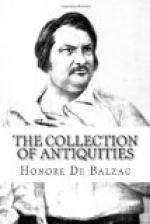In 1805, M. de la Roche-Guyon, the oldest son of an ancient family which had previously intermarried with the d’Esgrignons, made proposals in form through Maitre Chesnel for Mlle. Marie Armande Clair d’Esgrignon. She declined to hear the notary.
“You must have guessed before now that I am a mother, dear Chesnel,” she said; she had just put her nephew, a fine little boy of five, to bed.
The old Marquis rose and went up to his sister, but just returned from the cradle; he kissed her hand reverently, and as he sat down again, found words to say:
“My sister, you are a d’Esgrignon.”
A quiver ran through the noble girl; the tears stood in her eyes. M. d’Esgrignon, the father of the present Marquis, had married a second wife, the daughter of a farmer of taxes ennobled by Louis XIV. It was a shocking mesalliance in the eyes of his family, but fortunately of no importance, since a daughter was the one child of the marriage. Armande knew this. Kind as her brother had always been, he looked on her as a stranger in blood. And this speech of his had just recognized her as one of the family.
And was not her answer the worthy crown of eleven years of her noble life? Her every action since she came of age had borne the stamp of the purest devotion; love for her brother was a sort of religion with her.
“I shall die Mlle. d’Esgrignon,” she said simply, turning to the notary.
“For you there could be no fairer title,” returned Chesnel, meaning to convey a compliment. Poor Mlle. d’Esgrignon reddened.
“You have blundered, Chesnel,” said the Marquis, flattered by the steward’s words, but vexed that his sister had been hurt. “A d’Esgrignon may marry a Montmorency; their descent is not so pure as ours. The d’Esgrignons bear or, two bends, gules,” he continued, “and nothing during nine hundred years has changed their scutcheon; as it was at first, so it is to-day. Hence our device, Cil est nostre, taken at a tournament in the reign of Philip Augustus, with the supporters, a knight in armor or on the right, and a lion gules on the left.”
“I do not remember that any woman I have ever met has struck my imagination as Mlle. d’Esgrignon did,” said Emile Blondet, to whom contemporary literature is indebted for this history among other things. “Truth to tell, I was a boy, a mere child at the time, and perhaps my memory-pictures of her owe something of their vivid color to a boy’s natural turn for the marvelous.




